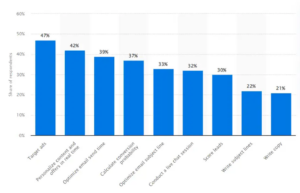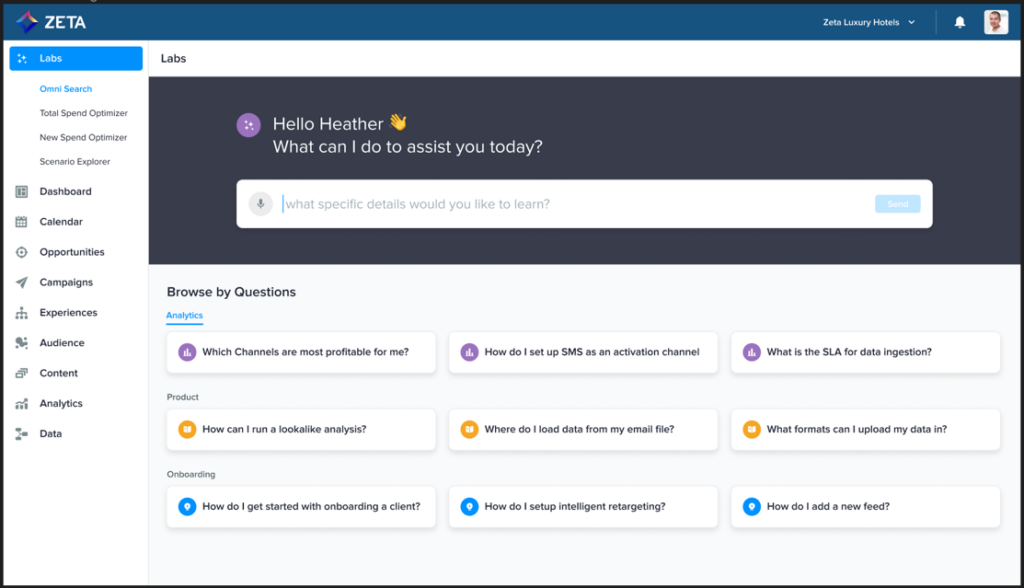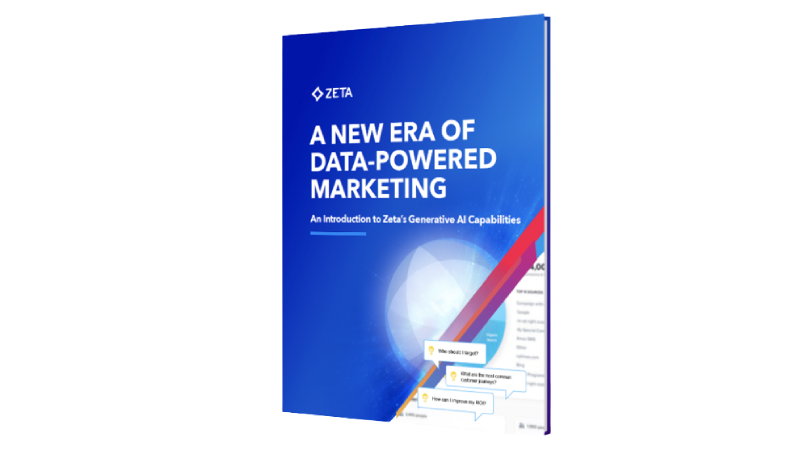
Why Marketers Need Generative AI for More Human Marketing
To further the impact of their ads, Stitch Fix deploys generative AI to for all Facebook and Instagram ad copy. The AI tool creates the copy, then human Stitch Fix copywriters come in to ensure it describes the outfit in the ad in an accurate, compelling way.
The brand explains:
“Prior to GPT-3, it would take roughly two weeks to plan and strategize each advertising campaign and draft the asset copy. Now, on average, it takes less than a minute for copywriters to review each asset and they receive a 77% pass rate.”
This is a perfect example of using generative AI to complement and augment—not replace—human capabilities—the formula more marketing leaders need to adopt posthaste.
A recent report from The Conference Board explains that while 87% of marketers have used AI or experimented with AI tools for at least one application, and 68% are now using AI at least “sometimes” in their daily work, these marketers are mostly tepid regarding how AI will impact creativity, work quality, and job availability.
This fear of artificial intelligence stems from a lack of understanding of the true potential of generative AI to (ironically) bring more empathy and personalization to the entire customer journey, while also helping marketers to advance in their careers.
And, if you’re leading a marketing team, it’s this fear that you need to help your team members overcome—for everyone’s advantage.
So Long, Farewell, to Transactional Marketing
Marketers have been incrementally chipping away at the goal of highly personalized marketing and optimized, omnichannel customer experiences for decades. But managing all the processes and workflows, plus collecting and analyzing all of the data, leaves little time for high-level thinking and strategic overhauls.
This leaves brands relying heavily on transactional marketing, focused largely on making one-time sales and neglecting the holistic, omnichannel journey and its impact on customer retention. Building loyalty requires careful attention to the customer’s experience and developing relationships over time, rather than a singular focus on sell, sell, sell.
Generative AI finally enables marketers to create more personalized experiences that drive meaningful growth by eliminating the roadblocks. We’re talking about real improvements to your strategies and business outcomes—not just chasing down the next transaction.
Take data analysis, for example.
Collecting data and crunching numbers is key to nearly every marketing initiative, allowing you to predict customer behavior, create effective segments, report on performance, and more. But most of your team’s time is spent collecting and analyzing the data, while only a small portion is allotted for using insights to make strategic recommendations. When you add generative AI to the mix, the tools can crunch the numbers, automate time-consuming processes, identify trends, find opportunities for improvement, and make recommendations for optimization in a fraction of the time.
Woah, wait a minute—does that mean we’ll be eliminating jobs?
No, the human marketer remains critical.
Ultimately, it’s the human marketers that can humanize the brand.
It’s the human that understands the business, the culture, and the customers.
It’s this human that comes up with the AI inputs to generate the most relevant outputs.
But without these resource-intensive tasks on their plates, your team members have time to step back and look at the proverbial forest through the trees. To think beyond open rates and click-throughs and Facebook follows, and consider whether marketing is truly meeting business objectives—and how you can make meaningful impacts.
Let’s make it more tangible.
Think about creating an email marketing campaign. Historically, we’ve spent an awful lot of time creating and testing subject lines. You probably draft and A/B test at least two subject lines based on whatever your copywriter thought would be the best options.
Test, wait, see results.
Hopefully, at least one is decent and your campaign can move forward. Maybe both perform rather poorly and you start from scratch.
With generative AI, the tools can audit all of your campaign history and the segments you’re sending to—and quickly create several subject lines that will perform well. That’s it. DONE. Now the team members that were spending days or weeks optimizing your emails have the bandwidth to consider your overarching email strategy:
- How is email contributing to the overall customer experience?
- How could we improve our email experience?
- Should email even be part of our experience?
- What should we test next?
The teams that embrace generative AI will see their roles evolve—but not become obsolete— because the tools allow us all to think bigger and take bolder actions. They’ll be able to use these insights to build more sophisticated experiences that better meet customer needs.
So long, farewell, to transactional marketing.
AI Benefit Beyond the Business—Building Up Employees
Not only is AI a minimal risk to human marketers, it also presents a valuable opportunity for improving job satisfaction and career development. Because AI elevates the role of the human in the organization, it provides the opportunity for people to truly grow and shine in their roles.
As Debbie Weinstein, Vice President and Managing Director of Google, UK and Ireland, explains in The Drum:
“…marketers find themselves in an environment of unparalleled complexity where the choice to embrace and engage with AI can transform their daily activities and facilitate even more strategic and higher value output than ever before.”
Sunshine Farzan, Global Head of Marketing & Communications at Standard Chartered Bank, agrees with Weinstein and explains in Forbes that AI accelerates marketers’ career development by:
- Fostering collaboration and innovation
- Encouraging a data-driven mindset for decision making
- Prioritizing high-value activities
Rob Schimek, Group CEO at insurtech company boitech, whose team has harnessed the power of ChatGPT to foster innovation, believes the collaborative environment powered by AI supports both continuous learning, as well as a sense of ownership and professional growth among team members.
Schimek is a firm believer in the complementary relationship of marketers and machines to benefit both brands and employees:
“By integrating AI into our brainstorming processes, we can harness diverse ideas and perspectives, and deliver innovative end-products to meet more customer needs. The synergy between humans and AI amplifies our collective potential, boosts productivity, and enables transformative outcomes for both tech and our partners.”
Real World AI Examples with Real Results
Many marketers are already finding meaningful ways to deploy generative AI to drive performance improvements, create better experiences, and accelerate growth. Some of the top activities marketers are trusting to AI include:
- Targeting ads
- Personalizing content and offers in real time
- Optimizing email send times
- Calculating conversion probability
- Optimizing email subject lines
(Source: Statista)
Here’s a look at how a few real companies are deploying AI to these ends.
Credit card company achieves 45% lift with AI-driven Next Best Offer
Next best offer programs are typically run by whatever the business wants to sell. Maybe there’s too much inventory on certain SKUs, or management wants to drive a new product to show launch success.
But these aren’t customer-focused or data-driven offers.
One of the largest credit card issuers decided they needed smarter next best offer programs. Using real-time decisioning powered by Zeta, they shifted from single thread (regressive) to multi-modality prediction for 20+ products.
This new, customer-centric approach to decisioning incorporates variables such as browser events, authentication status, and credit standing combined with Zeta’s in motion attributes and pre-authenticated eligible card member data for improved personalization performance.
Customers appreciated the more personalized approach. Processing 17 million site interactions per day with a 300-millisecond average response rate, the new decisioning drove:
- 85% improvement in prediction accuracy
- 45% average instant lift in conversions
Optimizing Email Send Times Drives Eyeballs and Interest for Retail and Financial Senders
Email send time is not usually intentional or intelligent. Go-live dates and times are very much governed by internal teams, hand offs, and sign offs—not by the customer, their interactions, or their shifting behavior across devices and seasonality.
One of our clients was falling into this internal-drivers trap.
A marketing services company that runs various retail and financial services marketing initiatives was relying on standardized deployment times for their email marketing campaigns.
The problem was that not everyone opens their email at their standard send time of 10:00 am. And even if recipients do open the email, 10:00 am might not be a time that specific customer segments are likely to click through and shop.
To transition away from this one-size-fits-all approach, the marketing company used AI and machine learning built into Zeta’s Prime Time solution to understand the engagement habits of individual customers — and optimize send times accordingly.
Compared to business as usual, the AI-driven email send times not only increased opens, but also engagement:
- 3% increase in open rate
- 7% increase in click-to-open rate
- 16% increase in click rate
Global Fashion Brand Increases Gross Margin by Adding AI to Existing Campaigns
Many shoppers are discount-driven, but offering discounts to shoppers that don’t need them can tank your margin.
One of the world’s leading fashion brands uses AI-driven signals from Zeta’s Data Cloud in their marketing campaigns to identify shoppers with price sensitivity. This allowed the brand to reduce discounts to price-agnostic customers, saving the savings for the discount-driven audiences.
This translated into a forecasted 17% increase in gross margin.
Move Your Team Boldly Forward
Generative AI is a powerful tool that can help your marketing team move beyond transactional marketing to create more personalized and effective experiences for your customers. By automating time-consuming tasks and freeing up your team members to focus on strategic thinking, generative AI can help you to:
- Improve marketing performance
- Save time and money
- Advance marketers in their careers
It’s your job to align your team members with these advantages and quell any uncertainty surrounding this new and powerful technology.
As Weiner explained:
“Let’s be clear: AI is not going to replace the knowledge and experience people bring to the table. AI technology needs to be guided. That guidance, expertise and understanding of your brands comes from you. I see AI as a tool that helps people focus on what they are good at and do more of what they love.”





